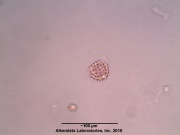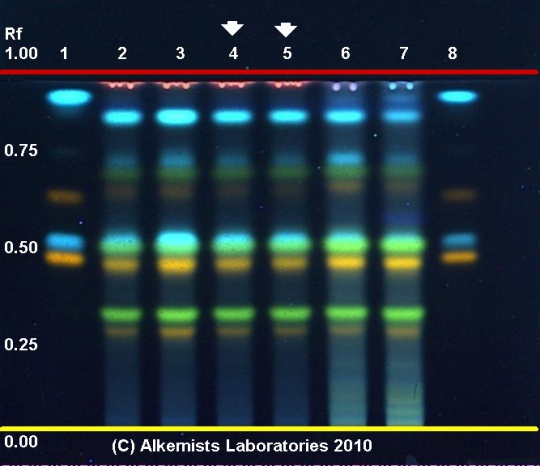Calendula officinalis (flower)
m (Italicized scientific name) |
|||
| Line 16: | Line 16: | ||
=HPTLC Entries= | =HPTLC Entries= | ||
| + | {{HPTLC | source=Elan M. Sudberg, Alkemist Laboratories | ||
| + | | description=Marigold (flower) (''Calendula officinalis'') | ||
| + | | companyimage=AP-LOGO-Laboratories Crop - Copy.jpg | ||
| + | | companyURL=http://www.alkemist.com | ||
| + | | mainimage=Calendula_officinalis_-_Alkemists_Laboratories.jpg | ||
| + | | caption1=''Calendula officinalis'' HPTLC ID - Natural Product Reagent + PEG UV 365 nm | ||
| + | | stationaryphase=Silica gel 60, F254, 10 x 10 cm HPTLC plates | ||
| + | | mobilephase=ethyl acetate: HCOOH: Acetic acid: H2O [10/1.1/1.1/2.4] | ||
| + | | prep=0.3 g + 3 ml CH3OH sonicate/heat @ 50° C ~ 1/2 hr. | ||
| + | | detection=Natural Product Reagent + PEG -> UV 365 nm | ||
| + | | lanes= Lanes, from left to right (Track, Volume, Sample): | ||
| + | # 1 μL Rutin, Caffeic Acid, Hyperoside, Chlorogenic Acid ~ 0.1% in Methanol | ||
| + | # 3 μL ''Calendula officinalis''-1 (flower) | ||
| + | # 3 μL ''Calendula officinalis''-2 (flower) | ||
| + | # 3 μL ''Calendula officinalis''-3 (flower) | ||
| + | # 3 μL ''Calendula officinalis''-3 (flower) | ||
| + | # 3 μL ''Calendula officinalis''-4 (flower) | ||
| + | # 3 μL ''Calendula officinalis''-5 (flower) | ||
| + | # 1 μL Rutin, Caffeic Acid, Hyperoside, Chlorogenic Acid ~ 0.1% in Methanol | ||
| + | |||
| + | Reference materials used here have been authenticated by macroscopic, microscopic &/or TLC studies according to the reference source cited below held at Alkemists Laboratories, Costa Mesa, CA. | ||
| + | |||
| + | | reference=Plant Drug Analysis, Wagner, H., 1996 | ||
| + | | }} | ||
| + | |||
=Other Points of Interest= | =Other Points of Interest= | ||
[[Category:blank]] | [[Category:blank]] | ||
Revision as of 23:45, 1 December 2012
Contents |
Introduction
Macroscopic Entries
Microscopic Entries
|
HPTLC Entries
|
Marigold (flower) (Calendula officinalis) Lane Assignments Lanes, from left to right (Track, Volume, Sample):
Reference materials used here have been authenticated by macroscopic, microscopic &/or TLC studies according to the reference source cited below held at Alkemists Laboratories, Costa Mesa, CA. Stationary Phase Silica gel 60, F254, 10 x 10 cm HPTLC plates Mobile Phase ethyl acetate: HCOOH: Acetic acid: H2O [10/1.1/1.1/2.4] Sample Preparation Method 0.3 g + 3 ml CH3OH sonicate/heat @ 50° C ~ 1/2 hr. Detection Method Natural Product Reagent + PEG -> UV 365 nm Reference see Plant Drug Analysis, Wagner, H., 1996
|
Other Points of Interest
Cite error: <ref> tags exist, but no <references/> tag was found


